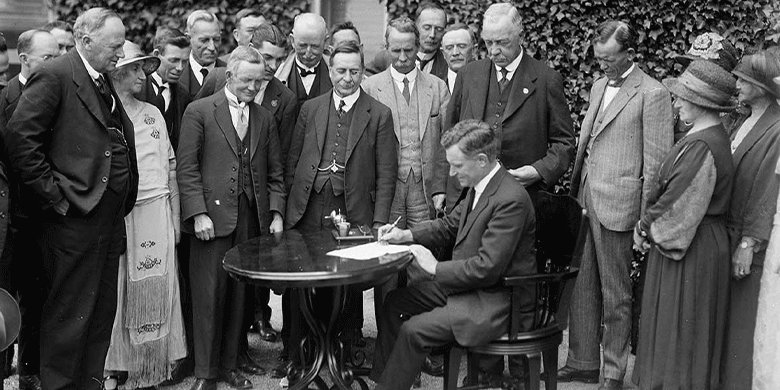
23 April, 2024
Pens Used for Famous Signings of Documents: A Journey Through History
In the annals of history, some pens have done more than just write; they have signed documents that changed the course of human events. These pens are more than mere writing instruments; they symbolise pivotal moments in history. Below are some iconic pens that have been used to sign ten significant documents, leaving an indelible mark on our world.
1. The Montblanc Pen: Treaty of Versailles (1919)
Historical Context
End of World War I: The Treaty of Versailles, signed in 1919, was a pivotal moment in world history, officially marking the end of World War I. This treaty had profound and lasting impacts on the geopolitical landscape of the 20th century.
Symbolic Signing: The use of a Montblanc pen for such a significant event underlines the importance of the act of signing itself, transforming the pen from a mere tool to a symbol of peace and resolution.
The Pen: Montblanc's Legacy
Montblanc's Prestige: At the time of the Treaty of Versailles, Montblanc was already renowned for its high-quality writing instruments. Founded in 1906, the brand had quickly established a reputation for luxury and craftsmanship.
Likely Model: While the exact model used for the Treaty of Versailles is not documented, it was likely one of Montblanc's early fountain pen models, known for their innovative design and superior functionality. Given the era, it might have been a Montblanc Rouge et Noir or one of the early Meisterstück (Masterpiece) models which were launched in the 1920s.
2. Parker 51 Fountain Pen: United Nations Charter (1945)
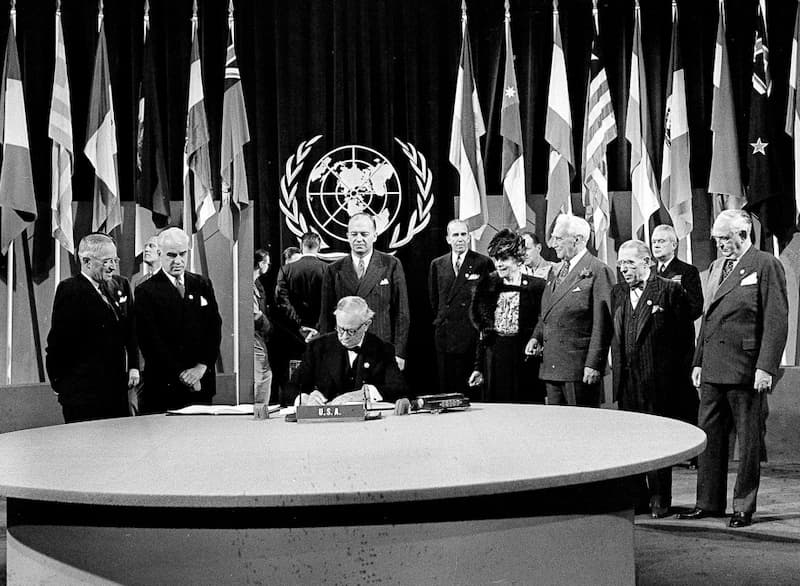
Historical Context
Foundation of the United Nations: The year 1945 marked a significant turning point in global diplomacy with the signing of the United Nations Charter. This historic event, following the devastation of World War II, established the United Nations, an international body dedicated to fostering peace and cooperation between nations.
Symbol of Hope and Unity: The signing ceremony, held in San Francisco, was more than a formal diplomatic gathering; it was a beacon of hope for a world emerging from the shadows of war. The establishment of the UN symbolised a collective commitment to preventing future conflicts and promoting international solidarity.
The Pen: Parker 51 Fountain Pen
Parker 51's Reputation: At the time of the UN Charter signing, the Parker 51 was one of the most sought-after writing instruments globally. Launched in the early 1940s, it was celebrated for its innovative design and reliable performance.
Design and Features: The Parker 51 stood out for its sleek, streamlined shape, a departure from the more traditional fountain pen designs of the time. It featured a hooded nib, a design choice that not only contributed to its modern appearance but also offered practical benefits such as preventing ink from drying out quickly and improving the smoothness of the writing experience.
Innovation in Ink Technology: The pen was renowned for its use of a fast-drying ink, specially formulated for this pen. This innovation addressed the common fountain pen issue of smudging, making it an ideal instrument for important documents like the UN Charter.
Symbolic Choice for the Occasion: The selection of the Parker 51 for the signing of the United Nations Charter was fitting in multiple ways. Its modern and forward-thinking design mirrored the progressive spirit of the United Nations. Furthermore, its reputation for reliability and excellence resonated with the Charter's purpose - to lay down a dependable foundation for international peace and cooperation.
3. The Cross Townsend Black Lacquer Fountain Pen: The Good Friday Agreement (1998)
Historical Context
The Good Friday Agreement: In 1998, a significant stride toward peace in Northern Ireland was made with the signing of the Good Friday Agreement. This agreement was pivotal in the Northern Ireland peace process, aiming to end decades of conflict and establish a framework for political reconciliation and cooperation.
A Symbol of Peace and Hope: The signing of this agreement marked a new era in Northern Irish and British history. It was a moment filled with hope and the promise of a peaceful future, bringing together opposing factions to agree on a shared path forward.
The Pen: Cross Townsend Black Lacquer Fountain Pen
The Elegance of Cross Townsend: For such a momentous occasion, the choice of the Cross Townsend pen was highly symbolic. Known for its elegance and sophistication, the Cross Townsend is more than just a writing instrument; it's a statement piece.
Design and Craftsmanship: It is renowned for its sleek design and exquisite craftsmanship. The black lacquer model, in particular, exudes a sense of classic style with a contemporary twist. The pen's body is typically finished with a highly polished lacquer and complemented by gold or silver accents, adding to its luxurious appearance.
A Fit for Historic Signings: The use of a Cross Townsend pen for the signing of the Good Friday Agreement highlighted the gravitas of the event. Its refined design and flawless performance made it an ideal match for an occasion that was about not just ending conflict, but also about writing a new chapter in history.
4. A Space Pen: Outer Space Treaty (1967)
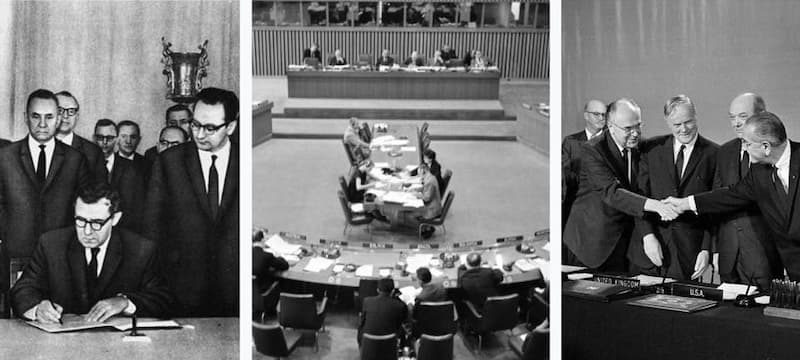
Historical Context
The Outer Space Treaty: In 1967, a landmark treaty was signed that shaped the future of space exploration - the Outer Space Treaty. This treaty set the foundational principles governing the activities of states in the exploration and use of outer space, including the prohibition of placing nuclear weapons in space, the avoidance of contaminating celestial bodies, and the notion that space should be free for exploration by all nations.
A New Era in Space Exploration: The signing of this treaty was not just a diplomatic achievement but also a reflection of the era's technological advancements and aspirations for peaceful space exploration. It marked the height of the space race and symbolised a commitment to using outer space for peaceful purposes.
The Pen: The Fisher Space Pen
Innovation for Extreme Conditions: The pen used to sign this monumental treaty was the Fisher Space Pen, a pen uniquely designed to function in the challenging conditions of space. Developed by inventor Paul Fisher, this pen could write in zero gravity, making it an ideal tool for astronauts.
Technical Features: It is known for its pressurised ink cartridge, which allows it to write in various extreme conditions, including zero gravity, underwater, over grease, and at temperatures ranging from -30 to 250 degrees Fahrenheit. This capability is due to the pen's thixotropic ink, which remains solid until the pen's rolling ball liquefies it, allowing it to flow smoothly onto the writing surface.
Symbolism of the Space Pen: Using the Fisher Space Pen for the signing of the Outer Space Treaty was symbolic in many ways. It underscored the technological innovation that defined the space age. The pen's ability to write in zero gravity represented the spirit of the treaty – exploration and cooperation in the new frontier of outer space.
5. The Sheaffer Pen: Camp David Accords (1978)
Historical Context
The Camp David Accords: In 1978, a significant step towards peace in the Middle East was taken with the signing of the Camp David Accords. These historic agreements, brokered by U.S. President Jimmy Carter, were signed by Egyptian President Anwar Sadat and Israeli Prime Minister Menachem Begin. The accords marked the first time an Arab country recognised Israel and were a monumental step toward achieving peace in a region fraught with conflict.
A Landmark in Diplomacy: The signing was not just a diplomatic achievement but also a symbol of hope and the potential for reconciliation between long-standing adversaries. It showed the world that through dialogue and negotiation, even the most entrenched conflicts could find a path to resolution.
The Pen: Sheaffer Fountain Pen
A Symbol of Elegance and Diplomacy: The Sheaffer pen used to sign the Camp David Accords was a fitting choice for such a momentous occasion. Sheaffer, a brand known for its elegance, classic design, and unparalleled reliability, mirrored the significance and the gravity of the event.
Design and Craftsmanship: They are celebrated for their timeless design, often featuring sleek, polished bodies and gold or silver trims. The pen likely used for the Camp David Accords would have had a fine or medium nib, perfect for the clear and decisive signatures required on such a historic document.
The Writer’s Pen: Known as a writer’s pen for its smooth ink flow and comfortable grip, it would have offered a sense of solidity and purpose in each stroke, embodying the seriousness and commitment of the signatories.
6. The Parker Duofold: NATO Treaty (1949)
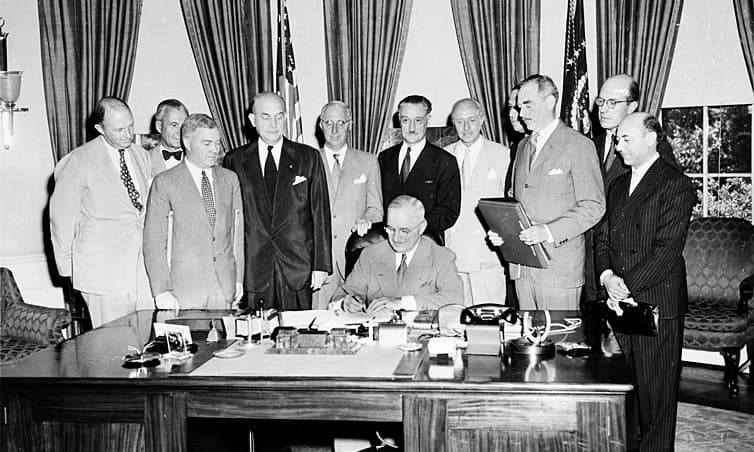
Historical Context
Establishment of NATO: The signing of the North Atlantic Treaty in 1949 was a defining moment in post-World War II history. This treaty established the North Atlantic Treaty Organisation (NATO), a powerful military alliance formed in response to growing geopolitical tensions and the threat of Soviet expansionism.
A New Era of Defense and Cooperation: The NATO Treaty signified a commitment to collective defense and marked the beginning of a new era in international relations. It represented a united front among Western nations, emphasising cooperation and mutual support in the face of potential threats.
The Pen: Parker Duofold
An Icon of Durability and Design: The Parker Duofold, chosen for this momentous signing, is a pen that carries with it a reputation for both elegance and resilience. First introduced in the 1920s, it has been a flagship model for Parker, embodying the brand's commitment to quality and innovative design.
Characteristics of the Duofold: Known for its bold design, the Parker Duofold typically features a large, well-balanced barrel, making it a commanding presence in any setting. It often boasts a striking resin finish, available in various colours, with gold or chrome accents that add to its distinguished appearance.
Writing Quality: It is not just about looks; it is also celebrated for its superior writing performance. Its nib, usually made of gold, offers a smooth and consistent ink flow, ensuring a reliable and enjoyable writing experience - a necessity for signing such a significant document.
Symbolic Resonance: The choice of the Parker Duofold for signing the NATO Treaty was symbolic in multiple ways. Its robustness and reliability reflected the strength and enduring nature of the alliance being formed. At the same time, its distinguished design mirrored the gravity and importance of the occasion.
7. The Waterman Pen: The Treaty of Sevres (1920)
Historical Context
End of an Empire: The Treaty of Sevres in 1920 marked the dissolution of the Ottoman Empire following World War I. This treaty, signed by the Allied Powers and representatives of the Ottoman Empire, redefined national boundaries and had profound implications for the Middle East and beyond.
A New Geopolitical Landscape: The treaty, though later superseded by the Treaty of Lausanne, laid the groundwork for the modern state system in the Middle East. It symbolised the end of centuries of Ottoman rule and the emergence of new nations.
The Pen: Waterman
A Legacy of Innovation: The Waterman pen, chosen for this historic signing, was a product of one of the most renowned pen manufacturers of the time. Founded by Lewis Edson Waterman, the company was known for its innovation in fountain pen technology, particularly the development of the first reliable ink flow system.
Writing Excellence: The choice of a Waterman pen for the Treaty of Sevres was likely influenced by its reputation for excellent writing performance. The smooth ink flow and reliability of Waterman pens made them suitable for the solemnity and significance of treaty signings.
Symbolic Choice: Using a Waterman pen for such a pivotal document in world history emphasised not only the seriousness of the occasion but also the forward-thinking attitude of the signatories. The pen, a symbol of modernity and innovation, was befitting for an agreement that was reshaping the world.
8. A Custom-Made Pen: Maastricht Treaty (1992)
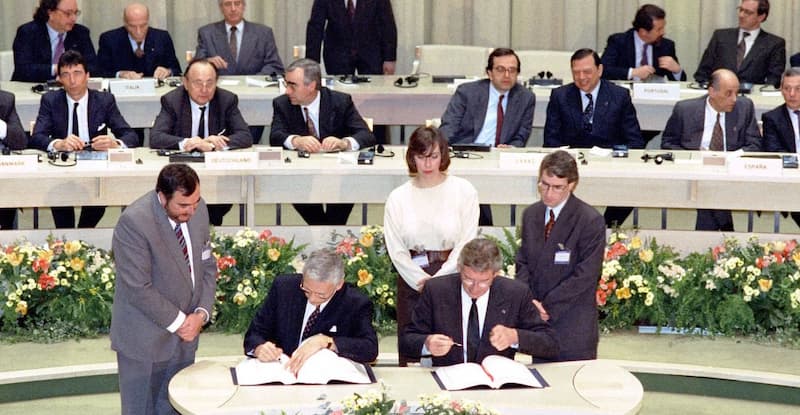
Historical Context
Birth of the European Union: The Maastricht Treaty, signed in 1992, was a monumental moment in European history. It marked the formal foundation of the European Union (EU), a significant step in the continent's journey towards closer economic and political integration.
A New Chapter in Europe: This treaty transformed the structure of the European Community, introducing new forms of cooperation in foreign policy, defense, justice, and home affairs. It was a visionary document that laid the groundwork for the modern EU.
The Pen: A Symbol of Unity and Innovation
Custom-Made for the Occasion: The pen used to sign the Maastricht Treaty was not just any pen; it was custom-made for this historic event. This choice reflected the unique and pioneering spirit of the treaty itself.
Design and Symbolism: While specific details of the pen's design might not be widely known, it can be imagined that it was crafted to symbolise the unity and diversity of the European nations. The pen likely incorporated elements or motifs representing the member states, embodying the essence of collaboration and shared destiny.
Craftsmanship and Quality: A custom-made pen for such a significant signing would have been made with the highest level of craftsmanship. It would have been designed not only for aesthetic appeal but also for functionality, ensuring a smooth and reliable writing experience during the signing ceremony.
More Than a Writing Tool: The use of a specially made pen for the Maastricht Treaty was a powerful symbol. It was an embodiment of the treaty's groundbreaking nature, representing a new era in European cooperation. The pen, in this context, was more than just a tool for signing; it was a part of history being made.
9. The S.T. Dupont Pen: The Treaty of Lisbon (2007)
Historical Context
A Milestone in European Integration: The Treaty of Lisbon, signed in 2007, marked a significant development in the European Union's history. It amended the two core treaties which form the EU's constitutional basis, streamlining EU institutions and enhancing decision-making efficiency.
Redefining Europe's Future: The treaty was crucial in redefining the functioning of the EU to better reflect the realities of a 27-member union. It was a testament to the adaptability and resilience of the European project, setting a new course for collective action and unity among member states.
The Pen: S.T. Dupont
Synonymous with Luxury and Craftsmanship: The choice of an S.T. Dupont pen for the signing of such a consequential treaty was fitting, given the brand's reputation for luxury and fine craftsmanship. S.T. Dupont, a French manufacturer known for its high-end writing instruments, has long been associated with elegance and sophistication.
Design Excellence: They are a work of art, often featuring exquisite materials like gold, silver, and precious lacquer. The pen used for the Treaty of Lisbon would have likely embodied this tradition of excellence, combining aesthetic beauty with functional perfection.
Precision Writing Instrument: Beyond their visual appeal, they are celebrated for their precise and smooth writing capabilities. Such a pen would provide a flawless signing experience, befitting the gravity of the occasion.
Symbolic Choice: Using an S.T. Dupont pen for the Treaty of Lisbon symbolised not only the elegance and solemnity of the event but also reflected the union's commitment to quality, excellence, and a shared vision for the future.
10. The King’s Gold Pen: The Instrument of Surrender (Japan, 1945)
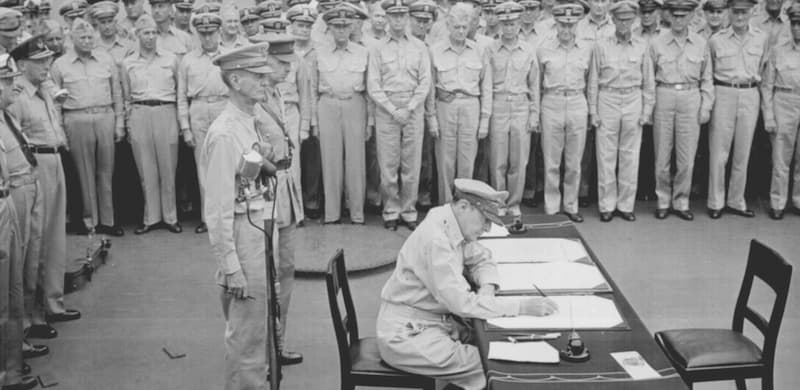
Historical Context
A Pivotal Moment in World History: The official surrender of Japan in 1945, marking the end of World War II, is one of the most significant events in modern history. This surrender brought to a close a devastating global conflict and opened the doors to a new era of peace and reconstruction.
A Symbolic Ceremony: The signing ceremony, held on the USS Missouri in Tokyo Bay, was laden with symbolism and marked by the presence of high-ranking officials from the Allied forces and the Japanese government. It was a moment that the entire world watched, marking the transition from war to peace.
The Pen: The King’s Gold Pen
Material and Craftsmanship: The King’s Gold Pen, used to sign the Instrument of Surrender, was a remarkable object, made entirely of solid gold. This choice of material was deeply symbolic, representing both the value of peace and the solemnity of the occasion.
Design and Significance: While specific design details of the pen are not widely recorded, it can be presumed that the pen was crafted with the utmost skill, befitting its use in such a historic event. The use of gold, a noble and precious metal, signified not just the end of hostilities but also the hope for a prosperous and peaceful future.
Symbol of a New Beginning: The use of such an extraordinary pen for the signing ceremony underscored the significance of the moment. It was a tool that finalised the conclusion of one of the darkest chapters in human history and symbolised the collective desire for a brighter, more peaceful future.
A Witness to History: The King’s Gold Pen, in its grandeur and symbolism, was more than a writing instrument; it was a witness to history. It represented a world weary of war and yearning for peace, and its use in this context elevated it from a mere pen to an artifact of historical importance.
Conclusion
Each of these pens, in their own right, has played a role in shaping the course of history. From treaties that ended wars to those that forged new alliances and organisations, the pens used in these signings were not just tools of ink; they were symbols of change, hope, and new beginnings. So, the next time you pick up a pen, think of the power it holds, not just to write words, but to make history.
The Pens Only Team

